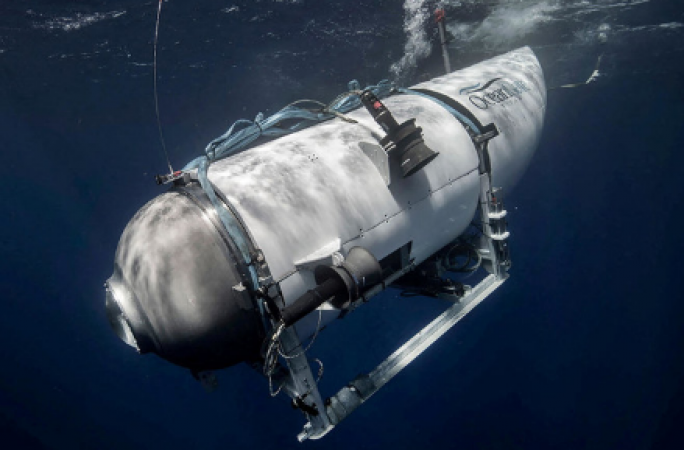
USA; As the possible final hours of oxygen left on board the tiny vessel ticked off the clock on Thursday morning, the race against time to find a submersible that vanished on its way to the Titanic wreckage site entered a new phase of desperation.
Rescuers have hurried more ships and vessels to the location of the disappearance in the hopes that the underwater sounds they have been hearing for a second day in a row will help them focus their urgent, global search. However, the Titan's crew was only equipped with a four-day supply of oxygen when it departed on Sunday morning at around 6 a.m.
Even those who expressed optimism cautioned that there are still many challenges to overcome, including locating the vessel, getting to it with rescue tools, and raising it to the surface.
Also Read: Rescuers search through building explosion debris in Paris
Absolutely, this is a search and rescue operation, he declared on Wednesday.
According to oceanographer Donald Murphy, who served as the International Ice Patrol's chief scientist, the region of the North Atlantic where the Titan disappeared on Sunday is also prone to fog and stormy weather, making it a very difficult environment for a search-and-rescue operation.
Meanwhile, according to recently discovered allegations, the submersible's development process included significant warnings about vessel safety.
Although the sounds that have been heard could help focus the search, Frederick said they had not yet been located or identified.
Also Read: Russia claims that having Emmanuel Macron attend the BRICS summit would be inappropriate
To be honest, he said, "We have no idea what they are.
The sounds have been described as "banging noises," according to retired Navy Capt. Carl Hartsfield, who is currently the director of the Woods Hole Oceanographic Systems Laboratory. However, he cautioned that search teams "have to put the whole picture together in context and they have to eliminate potential manmade sources other than the Titan."
Some experts found the report to be encouraging because submarine crews are instructed to bang on their submersibles' hulls in order to be picked up by sonar when they are unable to communicate with the surface.
In a statement released on Wednesday, the US Navy announced that it was sending a specialised salvage system that can lift "large, bulky, and heavy undersea objects such as aircraft or small vessels."
The Titan is 9,071 kilogrammes in weight. According to the US Navy's website, the Flyaway Deep Ocean Salvage System can lift up to 27,216 kg.
The CEO of the company leading the expedition, pilot Stockton Rush, is missing aboard the ship. A British explorer, two members of a Pakistani business family, and a Titanic expert are among his passengers. The mission was directed by OceanGate Expeditions.
Authorities launched a search in waters about 700 kilometres south of St. John's after receiving a report that the 6.7-meter carbon-fiber vessel was overdue.
According to officials, the Titan had a 96-hour oxygen supply, giving them until early Thursday morning to locate and raise the ship.
The estimated oxygen supply, according to Frank Owen, a submersible search and rescue specialist, is a useful "target" for searchers but is only based on a "nominal amount of consumption." Owen stated that the diver aboard the Titan would probably be giving advice.
According to letters the company submitted to a US District Court in Norfolk, Virginia, which is in charge of handling cases involving the Titanic shipwreck, at least 46 people successfully travelled on OceanGate's submersible to the Titanic wreck site in 2021 and 2022.
One of the business's original clients called a dive he took there two years ago a "kamikaze operation."
"Consider a few-meter-long metal tube with a metal sheet serving as the floor. You cannot endure. Not even close. Everyone is seated next to or on top of one another, said German adventurer and retired businessman Arthur Loibl. "You can't be afraid of close quarters."
He claimed that in order to save energy, all of the lights were turned off during the 2.5-hour descent and ascent, with only a fluorescent glow stick providing illumination.
The balancing weights and battery issue kept the dive from going as planned. The trip took 10.5 hours in total.
The use of a basic, readily available video game controller by OceanGate to control the Titan has drawn criticism. However, the company claims that many of the vessel's components are off-the-shelf due to their reliability.
Rush told the CBC in an interview last year that the controller is "super durable" and "meant for a 16-year-old to throw it around" as he demonstrated by flinging it around the cramped Titan's cabin. A few spares are kept on board, he said, "just in case."
The submersible had seven back-up systems, including an inflatable balloon, drop-off lead pipes, and sandbags, to get back to the surface.
The vessel is too deep for human divers to reach, according to Jeff Karson, an emeritus professor of earth and environmental sciences at Syracuse University. The temperature is just above freezing. He suggested that using a remotely controlled robot on a fibre optic cable might give you the best chance of getting to the submersible.
Also Read: In the Paris building explosion, four people were seriously hurt and two went missing
Karson said, "I'm sure it's awful down there. Hypothermia is a genuine risk because it feels like being in a snow cave.
According to documents, OceanGate had been informed that the experimental vessel's construction might pose catastrophic safety issues.
In a lawsuit filed in 2018, David Lochridge, director of marine operations for OceanGate, claimed that the company's certification and testing were insufficient and that doing so would "subject passengers to potential extreme danger in an experimental submersible."
The business insisted that Lochridge was "not an engineer and was neither hired nor asked to perform engineering services on the Titan." The company claims that the prototype ship, not the now-missing Titan, was the one that was being developed.